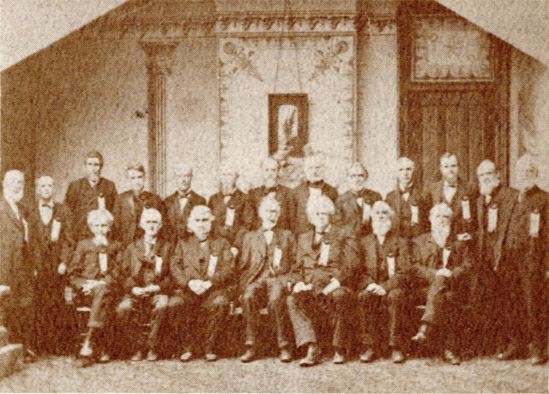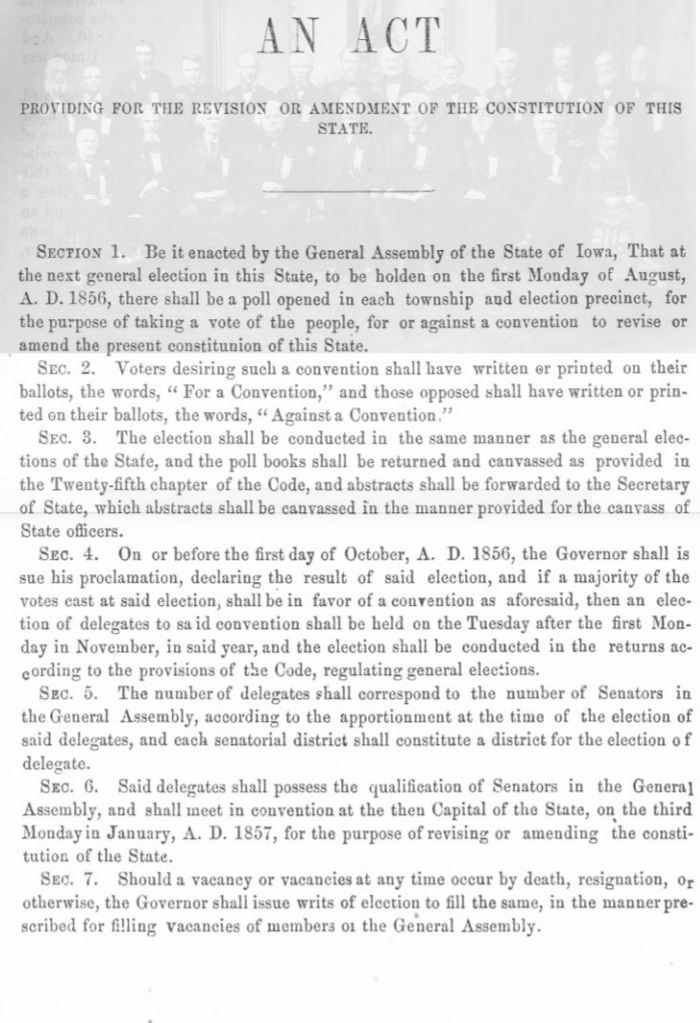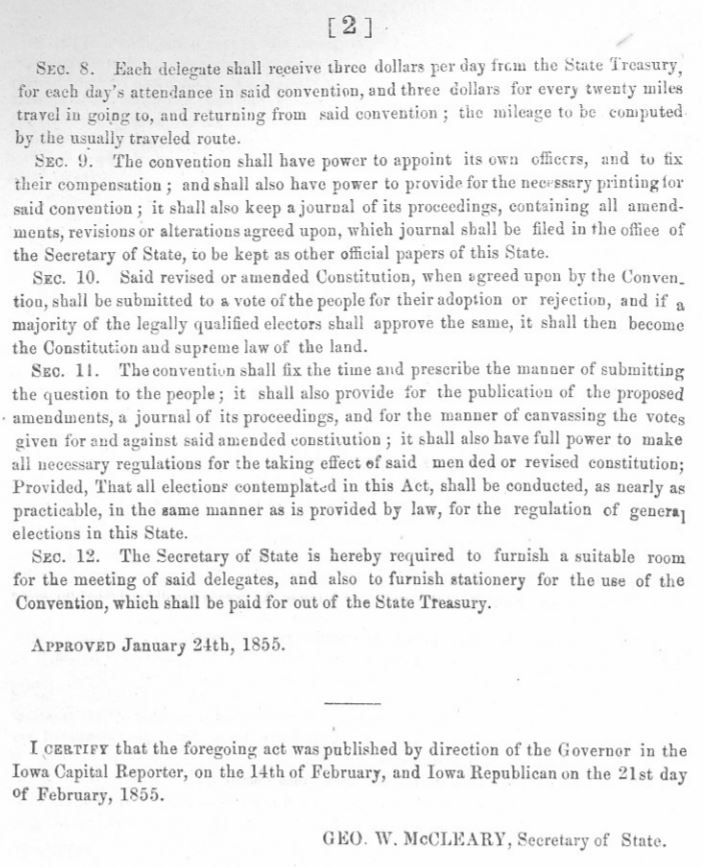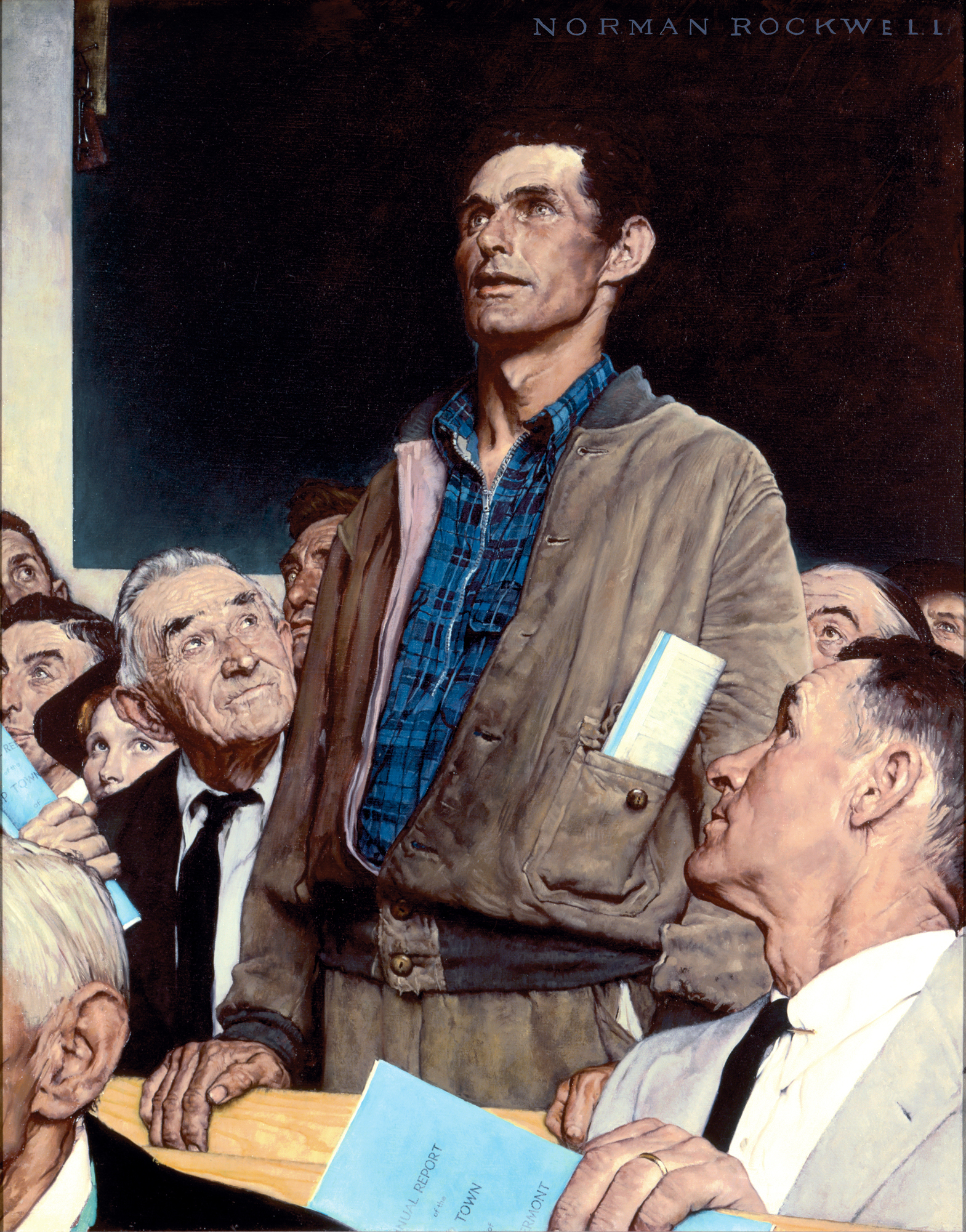The Iowa State Constitutional Convention Clearinghouse
This website provides news, pro & con, historical, and other information related to Iowa's constitutionally mandated November 3, 2020 referendum on whether to call a state constitutional convention.
Iowa’s Constitutions and Constitutional Conventions
Iowa has had two pre-statehood and two post-statehood constitutions. The first pre-statehood constitution was passed by Congress in 1836 when Iowa was part of the Territory of Wisconsin. The second pre-statehood constitution was passed by Congress in 1838 when Iowa became its own separate territory. Congress amended these “organic acts” multiple times.
Iowa’s statehood constitution was proposed by a voter elected constitutional convention and then ratified by voters in 1846. A revised version of that constitution was proposed by a voter elected constitutional convention and then ratified by voters in 1857. This is Iowa’s current state constitution.
Since Iowa became a territory in 1836, it has had four constitutions, called four constitutional conventions, and convened three constitutional conventions. In 1920, Iowa voters approved a constitutional convention, but the legislature refused to convene it, with some legislators saying that the people had been “hoodwinked” into calling it. Both in 1900 and 1970, initial election results appeared to indicate that the voters had approved a convention call, only to have the apparent call reversed in later days when all ballots were counted.
A question on whether to call a constitutional convention may be placed on the ballot either by the legislature or as a result of Iowa’s mandatory decennial referendum on whether to call a constitutional convention. The legislature has not placed the question on the ballot since 1857. Prior to 1857, when the legislature wanted to amend the constitution, calling a constitutional convention was the only way it could do so.

Iowa Constitutions Since 1836
Constitutions*
Constitutions Rejected by Voters**
Legislature Bypasses the Standard Convention Process in Passing a New Constitution ***
* Two pre-statehood constitutions and two post-statehood constitutions.
** Both in 1845.
*** In 1845, the Legislature resubmitted for voter ratification a convention proposed constitution that voters had already rejected but that the Legislature very much wanted the voters to ratify. Voters once again rejected the proposed constitution. This failed method of proposing a constitution may be unique in American state constitutional history since 1776–perhaps because it arguably violated Iowa’s existing constitution. If not unique, the method has been exceptionally rare.
In 1846, the Legislature passed legislation to convene a convention without first seeking voter approval for the convention call. That is, unlike 1844, it called a convention but still skipped the step of voter approval for the convention call. This method was uncommon prior to the 20th Century and has become very rare since.
Iowa Constitutional Conventions Since 1836
Conventions Convened*
Conventions Called by Voters****
Conventions Initiated by the Legislature**
Conventions Calls the Legislature Refused to Honor*****
Legislature Convention Calls Rejected by Voters***
Rejected Convention Calls Initially Reported As Approved******
* 1844, 1846, 1857.
** All five were prior to the advent of the periodic constitutional convention referendum, first implemented in 1870. The five were in 1840, 1842, 1844, 1846, and 1855.
*** Voters rejected two of the Legislature’s five calls. The rejections were in 1840 and 1842.
**** 1844, 1857, and 1920.
***** In 1920, a convention call was approved, which the Legislature refused to convene in compliance with the Constitution after playing a sophisticated blame game. The House and Senate each passed the required legislation to convene a convention, then blamed the other branch when they didn’t agree on a compromise version of the legislation in conference committee.
****** In 1900 and 1970. The final vote count in 1900 was 49.92% against, and 50.08% for–what given our modern (post Gore v. Bush) understanding of voting technology would be understood to be a statistical dead heat.
Data
Iowa’s Three Constitutions and Three Constitutional Conventions
Iowa’s Constitutions (each preceded by a constitutional convention)
| Date | Duration | Comment | |
| 1836 | 2 Years | 1st pre-statehood constitution. Provided by Congress for the Territory of Wisconsin, which then included Iowa. The people of Iowa were not given the opportunity to ratify this constitution. | |
| 1838 | 8 Years | 2nd pre-statehood constitution. Provided by Congress for the Territory of Iowa. The people of Iowa were not given the opportunity to ratify this constitution. | |
| 1846 | 11 Years | 1st statehood constitution. Iowa became a state on Dec. 28, 1846. This constitution was ratified by the people of Iowa. | |
| 1857 | 163 Years | 2nd statehood constitution, effective Sept. 3, 1957. This was the second and current constitution ratified by the people of Iowa and now includes 48 amendments. Iowa’s population of Iowa was 517,875 (based on the 1856 census) when this constitution was written. |
Convention Delegate Election and Profiles
| Election Date | Total # | Male # | Female # | Male % | Female % | White # | White % | Political Party |
| August 1844 | 72 | 72 | 0 | 100 | 0 | 72 | 100 | 21 Whigs; 51 Democrats |
| April 1846 | 32 | 32 | 0 | 100 | 0 | 32 | 100 | 10 Whigs; 22 Democrats |
| November 1856 | 36 | 36 | 0 | 100 | 0 | 36 | 100 | 21 Republicans; 15 Democrats |
Note: Prior to 1844, the Legislature twice failed to get the people to approve calling a convention. The procedures associated with convention calls were specified in the enabling act. For example, the 1842 enabling act specified that the people would vote on whether to call a convention at the general election in August 1842, that the convention would have 82 delegates that would be elected on the second Tuesday in October 1842, that the convention would convene in the Capital on the first Monday in November 1842, and the people would vote on whether to ratify the convention’s proposal(s) at the general election in August 1843.
Convention Duration & Cost
Start Date, End Date, Duration, Cost
| Start Date | End Date | Duration | Cost |
| October 7, 1844 | November 1, 1844 | 25 days | $7,854 |
| May 4, 1846 | May 19, 1846 | 15 days | $2,844 |
| January 19, 1857 | March 5, 1857 | 39 days | N.A. |
Iowa’s Convention Calls and Referendums
Iowa’s Legislature Initiates the Constitutional Convention Process*
|
Legislature Vote |
Standard Convention Process?** | Voters Approve Referendum? | Comments |
| July 31, 1840 | Yes | No | |
| February 16, 1842 | Yes | No | |
| February 12, 1844 | Yes | Yes | |
| June 10, 1845 | No | N.A. | Legislature resubmits to voters previously rejected convention proposed constitution without calling for a new convention. Nine state legislators in the opposition argue that this violates Iowa’s constitution, as the Legislature has no delegated powers to resubmit such a referendum on whether to ratify a constitution. The Legislature goes ahead with the referendum and the voters once again reject the proposed constitution. |
| January 17, 1846 | No | N.A. | This time the Legislature approved calling a convention without first asking the people whether they wanted to call another convention. |
| January 24, 1855 | Yes | Yes |
* With the mandatory periodic constitutional convention referendum, the Legislature doesn’t place the convention call on the ballot for voter approval, as the call is placed on the ballot automatically; that is, even if the legislature is opposed to calling a convention.
** The standard convention process, regardless of whether a convention is called by a legislature or periodic referendum, entails three steps: 1) voters choose whether to approve a referendum to call a convention, 2) voters elect delegates to a convention, and 3) voters choose whether to ratify a convention’s proposals. In 1844, Iowa’s Legislature skipped 1) and 2). In 1846, it skipped 1).
Iowa’s Referendum Calls to Convene a Constitutional Convention
| Vote Date* |
Yes # |
No # |
Yes % |
No % |
Called? |
| August 1840 |
937 | 2,907 | 24.38% | 75.62% | No |
| August 1842 |
4,129 | 6,825 | 37.69% | 62.31% | No |
| April 1844 |
6,719 | 3,974 | 62.84% | 37.16% | Yes |
| August 1856 |
32,790 | 14,612 | 69.17% | 30.83% | Yes |
| 1870 | 24,846 | 82,039 | 23.25% | 76.75% | No |
| 1880 | 69,762 | 83,784 | 45.43% | 54.57% | No |
| 1890 | 27,806 | 159,394 | 14.85% | 85.15% | No |
| 1900 | 176,337 | 176,892 | 49.92% | 50.08% | No |
| 1910 | 134,983 | 166,054 | 44.84% | 55.16% | No |
| 1920 | 279,652 | 221,763 | 55.77% | 44.23% | Yes** |
| 1930 | 140,667 | 195,356 | 41.86% | 58.14% | No |
| 1940 | 199,247 | 352,142 | 36.14% | 63.86% | No |
| 1950 | 221,189 | 319,704 | 40.89% | 59.11% | No |
| 1960 | 470,257 | 534,628 | 46.80% | 53.20% | No |
| 1970 | 204,517 | 214,663 | 48.79% | 51.21% | No |
| 1980 | 404,249 | 640,130 | 38.71% | 61.29% | No |
| 1990 | 179,762 | 491,179 | 26.79% | 73.21% | No |
| 2000 | 299,972 | 598,318 | 33.39% | 66.61% | No |
| 2010 | 317,577 | 649,316 | 32.85% | 67.15% | No |
* Note on election dates. The April 1846 election was for April township elections. The August 1840, August 1842, and August 1856 elections were for general elections. The periodic constitutional convention referendum elections beginning in 1870 were for general elections.
** The 1920 convention was called, but the Legislature refused to pass the enabling legislation to convene it. The House and Senate claimed they couldn’t agree on the terms for convening it.
Iowa’s Ratification of Constitutional Convention Proposals
| Vote Date | Yes # |
No # |
Yes % | No % | Comment |
| April 7, 1845 | 6,023 | 7,019 | 46.18 | 53.82 | Constitution proposed by the 1844 constitutional convention rejected 1st time. |
| August 1845 | 7,235 | 7,656 | 48.59 | 51.41 | The Legislature didn’t like the rejection, so resubmitted the same constitution a second time, which the people then rejected a second time. It is unclear if this resubmittal without calling another convention was constitutional. |
| Aug. 3, 1846 | 9,492 | 51.23 | 9,036 | 48.77 | Proposed constitution approved; presented to Congress and approved on December 28, 1846. |
| Aug. 3, 1857 | 40,311 | 38,681 | 51.03 | 48.97 | The convention’s main proposal; approved by voters. |
| Aug. 3, 1857 | 8,479 | 49,267 | 14.68 | 85.32 |
A separate convention amendment to make blacks equal to whites; rejected by voters. The specific question was: “Shall the word ‘white’ be stricken out of the constitution wherever it occurs?”
|
‘
Note on sources: many sources, especially those dealing with pre-20th Century elections, have many minor conflicts in the data they contain. Most of these conflicts are probably due to typos; for example an “8” transposed into a “6” in a four digit number. Even Benjamin Shambaugh’s authoritative The Constitutions of Iowa has discrepancies both within his text and with other reputable sources. Shambaugh was for 40 years the superintendent of the State Historical Society of Iowa and a professor of political economy at the University of Iowa. Where there have been conflicts, which may amount in an early source to no more than typographical errors (and then repeated by later sources), I have tried to go with what seemed the most authoritative source. Sometimes a seemingly well-defined concept has some ambiguity. For example, Shambaugh at various points says that Iowa’s 1844 constitutional convention had 73 and 72 delegates. It turns out, both answers are correct! The 73rd member appears never to have attended the convention. Most sources appear to go with the 72 delegate number.
I have considered contemporary Iowa state government sources as most authoritative, despite the Iowa Legislature’s track record since 1870 of opposition to calling a state constitutional convention in Iowa. One reason for the poor data may be the Iowa Legislature’s lack of interest in documenting its full record concerning its enthusiastic and repeated support for state constitutional conventions prior to 1857.
I may be using some data for purposes not originally intended. For example, I calculate voter participation rates in elections for calling a state constitutional convention based on the highest vote for any office on the ballot, which I take to be either the presidential or gubernatorial election depending on the year. But my sources on those election results may only report the results for, say, the top four gubernatorial or presidential candidates. If so, I may not have counted the votes for all the fringe candidates, which are generally not of interest to students of elections.
Documents
Primary Iowa Constitutional Documents
Iowa Constitution, Iowa Legislature. Available at https://www.legis.iowa.gov/law/statutory/constitution#:~:text=Iowa%20has%20held%20three%20constitutional,of%20the%20State%20of%20Iowa..
Constitution of the State of Iowa. State Library of Iowa. Available at http://publications.iowa.gov/135/1/history/7-7.html.
Constitution of the State of Iowa (codified). State Library of Iowa. Available at http://publications.iowa.gov/9883/1/CONSTITUTION_OF_THE_STATE_OF_IOWA.pdf
The Iowa Constitution. Iowa PBS. Available at http://www.iowapbs.org/iowapathways/mypath/iowa-constitution.
Shambaugh, Benjamin Franklin. Fragments of the Debates of the Iowa Constitutional Conventions of 1844 and 1846: Along with Press Comments and Other Materials on the Constitutions of 1844 and 1846. State Historical Society of Iowa, 1900. Available at https://books.google.com/books?hl=en&lr=&id=iA-SrpPQKoUC&oi=fnd&pg=PA1&dq=iowa+%22constitutional+convention%22&ots=d5BWUOee9R&sig=34fgWcZ1SVIS913aNZwoF9Cjm3g#v=onepage&q&f=false
Lord, William Blair. The debates of the Constitutional convention: of the state of Iowa, assembled at Iowa City, Monday, January 19, 1857. Vol. 1. Luse, Laue & Co., 1857. Available at
https://books.google.com/books?hl=en&lr=&id=HrmCAAAAIAAJ&oi=fnd&pg=PP9&dq=iowa+%22constitutional+convention%22&ots=wzIlE5GxsI&sig=iiu3R1zNG7pKJqIVeYj2YVEcthY#v=onepage&q=iowa%20%22constitutional%20convention%22&f=false
Shambaugh, Benjamin Franklin. Fragments of the Debates of the Iowa Constitutional Conventions of 1844 and 1846: Along with Press Comments and Other Materials on the Constitutions of 1844 and 1846. State Historical Society of Iowa, 1900.
The Debates of the Constitutional Convention of the State of Iowa. Iowa State Library. Available at https://web.archive.org/web/20160102105101/http://www.statelibraryofiowa.org/services/collections/law-library/iaconst/
Iowa Legislature Constitutional Convention Documentation
1844, 1846, and 1857 Convened Constitutional Conventions, Iowa Legislature. This provides links to many of the documents listed above. Available at https://www.legis.iowa.gov/law/statutory/constitution/constConventions.
Iowa Secretary of State Constitutional Convention Election Results
2010 Constitutional Convention Election Results (pages 6-7 )
2000 Constitutional Convention Election Results (page 1)
1990 Constitutional Convention Election Results (page 51)
1980 Constitutional Convention Election Results (page 7)
1970 Constitutional Convention Election Results (page 3)
1960 Constitutional Convention Election Results (page 5)
1950 Constitutional Convention Election Results (page 5)
1900 Constitutional Convention Election Results (page 251)
See also the Iowa Official Register, Iowa Secretary of State; e.g., the 1900 edition and many other editions include basic information on Iowa’s first three state constitutional conventions.
Secondary Iowa Constitutional Documents
Major Works
Schmidhauser, John Richard. Iowa’s Campaign for a Constitutional Convention in 1960. No. 30. McGraw-Hill, 1963.
Shambaugh, Benjamin Franklin. The Constitutions of Iowa. State Historical Society, 1934.
Stark, Jack. The Iowa State Constitution. Oxford University Press on Demand, 2011. A book review is available at https://ir.uiowa.edu/cgi/viewcontent.cgi?article=1694&context=annals-of-iowa. The current edition is Pettys, Todd E. The Iowa State Constitution. Oxford University Press, 2017. A preview is available at https://smile.amazon.com/Constitution-Oxford-Commentaries-Constitutions-United/dp/0190490837/ref=sr_1_2?dchild=1&keywords=the+iowa+state+constitution&qid=1593067716&s=books&sr=1-2.
Wiggins, Charles W. “Constitutional Convention Issue in Iowa (1960).” The Annals of Iowa 40, no. 3 (1970): 171-190. Available at https://ir.uiowa.edu/cgi/viewcontent.cgi?article=7937&context=annals-of-iowa
Brief Observations
Conserving Iowa’s Constitution. Iowa Secretary of State. 1989. Note: two page pamphlet. Available at https://web.archive.org/web/20151029115014/http://publications.iowa.gov/17455/1/ConservIA.pdf
Cook, Claude R. “Territorial and State Organization.” The Annals of Iowa 29, no. 8 (1949): 599-607. Available at https://ir.uiowa.edu/cgi/viewcontent.cgi?article=7058&context=annals-of-iowa
Iowas’s 1920 Unconvened Constitutional Convention.
See Schmidhauser, John Richard. Iowa’s Campaign for a Constitutional Convention in 1960. No. 30. McGraw-Hill, 1963, p. 3.
Iowas’s 1900 Unconvened Constitutional Convention.
H., F. I., “The Constitution of 1857 and the People.” The Annals of Iowa 8, no. 1 (1907): 65-71, p. 68. Available at https://ir.uiowa.edu/cgi/viewcontent.cgi?article=3391&context=annals-of-iowa. For a sense of how voting technology has changed and could be prone to error, see Time Travel Iowa: 1906 Voting Machine, Iowa PBS, .
The Iowa Legislature’s Last Enabling Act to Call a Constitutional Convention*


*The fifth and last time Iowa’s Legislature passed such an act was in 1855, when it sought to replace Iowa’s 1846 Constitution with what became its 1857 Constitution.
Evolution of Iowa’s Constitutional Amendment Rules since 1844
Constitution of 1844 (proposed by the convention but not ratified by the people)
ARTICLE 2.
Bill of rights.
2. All political power is inherent in the people. Government is instituted for the protection, security, and benefit of the people, and they have the right, at all times, to alter or reform the same, whenever the public good may require it.
ARTICLE XII.
On amendments to the constitution.
1. Any amendment or amendments to this constitution may be proposed in the senate or house of representatives; and, if the same shall be agreed to by a majority of all the members elected to each of the two houses, such proposed amendment shall be entered on their journals, with the yeas and nays thereon, and referred to the General Assembly then next to be chosen, and shall be published for three months previous to the time of making ·such choice; and if in the General Assembly then next chosen as aforesaid, such proposed amendment or amendments shall be agreed to by a majority of all the members elected to each house, then it shall be the duty of the General Assembly to submit such proposed amendment or amendments to the people, in such manner aud at such time as the General Assembly shall prescribe; and if the people shall approve and ratify such amendment or amendments, by a majority of all the qualified electors of the State voting for and against said amendment or amendments voting in their favor, such amendment or amendments shall become part of this constitution. When any amendment or amendments to this constitution shall be proposed in pursuance of the foregoing provisions, the same shall, at each of the said sessions, be read three several days in each house. The General Assembly shall not propose the same amendments to this constitution oftener than once in six years.
2. And if, at any time, two-thirds of the senate and house of representatives shall think it necessary to revise or change this constitution, they shall recommend to the electors at the next election for members of the legislature to vote for or against a convention; and if it shalt appear that a majority of the electors voting at such election have voted in favor of calling a convention, the legislature shall, at its next session, provide by law for calling a convention, to be holden within six months after the passage of such law, and such convention shall consist of a number of members
not less than of both branches of the legislature.
Constitution of 1846
ARTICLE 1.
BILL OF RIGHTS.
2. Political power. All political power is inherent in the people. Government is instituted for the protection, security, and benefit of the people, and they have the right, at all times, to alter or reform the same, whenever the public good may require it.
ARTICLE 10.
AMENDMENTS TO THE CONSTITUTION.
1. If at any time the general assembly shall think it necessary to revise or amend this constitution, they shall provide by law for a vote of the people for or against a convention, at the next ensuing election for members of the general assembly. In case a majority of the people vote in favor of a convention, said general assembly shall provide for an election of delegates to a convention, to be held within six months after the vote of the people in favor thereof.
Constitution of 1857
ARTICLE 1.
BILL OF RIGHTS.
Political power. SEC. 2. All political power is inherent in the people. Government is instituted for the protection, security, and benefit of the people, and they have the right, at all times, to alter or reform the same, whenever the public good may require it.
ARTICLE X.
AMENDMENTS TO THE CONSTITUTION.
How proposed — submission. SECTION 1. Any amendment or amendments to this Constitution may be proposed in either House of the General Assembly; and if the same shall be agreed to by a majority of the members elected to each of the two Houses, such proposed
amendment shall be entered on their journals, with the yeas and nays taken thereon, and referred to the Legislature to be chosen at the next general election, and shall be published, as provided by law, for three months previous to the time of making such choice; and if, in the
General Assembly so next chosen as aforesaid, such proposed amendment or amendments shall be agreed to, by a majority of all the members elected to each House, then it shall be the duty of the General Assembly to submit such proposed amendment or amendments to the people, in such manner, and at such time as the General Assembly shall provide; and if the people shall approve and ratify such amendment or amendments, by a majority of the electors qualified to vote for members of the General Assembly, voting thereon, such amendment or amendments shall become a part of the Constitution of this State.
More than one amendment. SEC. 2. If two or more amendments shall be submitted at the same time, they shall be submitted in such manner that the electors shall vote for or against each of such amendments separately.
Convention. SEC. 3. [At the general election to be held in the year one thousand eight hundred and seventy, and in each tenth year thereafter, and also at such times as the General Assembly may, by law, provide, the question, “Shall there be a Convention to revise the Constitution, and amend the same?” shall be decided by the electors qualified to vote for members of the General Assembly; and in case a majority of the electors so qualified, voting
at such election, for and against such proposition, shall decide in favor of a Convention for such purpose, the General Assembly, at its next session, shall provide by law for the election of delegates to such Convention.]*
*In 1964 this section was repealed and a substitute adopted in lieu thereof:
Amendment of 1964
[Amendment 22] Section three (3) of Article ten (X) of the Constitution of the State of Iowa is repealed and the following adopted in lieu thereof:
Constitutional convention. SEC. 3. At the general election to be held in the year one thousand nine hundred and seventy, and in each tenth year thereafter, and also at such times as the General Assembly may, by law, provide, the question, “Shall there be a Convention to revise the Constitution, and propose amendment or amendments to same?” shall be decided by the electors qualified to vote for members of the General Assembly; and in case a majority of the electors so qualified, voting at such election, for and against such proposition, shall decide in favor of a Convention for such purpose, the General Assembly, at its next session, shall provide by law for the election of delegates to such Convention, and for submitting the results of said Convention to the people, in such manner and at such time as the General Assembly shall provide; and if the people shall approve and ratify such amendment or amendments, by a majority of the electors qualified to vote for members of the General Assembly, voting thereon, such amendment or amendments shall become a part of the constitution of this state. If two or more amendments shall be submitted at the same time, they shall be submitted in such a manner that electors may vote for or against each such amendment separately.
Source: The Iowa Legislature. Available at https://www.legis.iowa.gov/law/statutory/constitution/constConventions?year=1844
https://www.legis.iowa.gov/law/statutory/constitution/constConventions?year=1846
https://www.legis.iowa.gov/law/statutory/constitution/constConventions?year=1857
